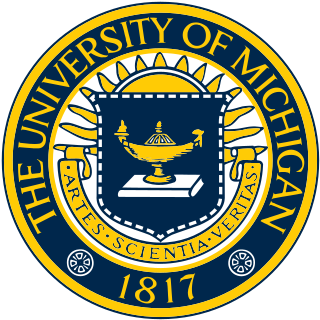Top Qs
Timeline
Chat
Perspective
College of Literature, Science, and the Arts
Liberal arts and sciences school in Michigan From Wikipedia, the free encyclopedia
Remove ads
The University of Michigan College of Literature, Science, and the Arts (LSA) is the liberal arts and sciences school of the University of Michigan in Ann Arbor. Established in 1841, the college is home to both the University of Michigan Honors Program and Residential College.
This article has multiple issues. Please help improve it or discuss these issues on the talk page. (Learn how and when to remove these messages)
|
Remove ads
History
This section needs expansion with: details about the first 150 years of the school's history, particularly its founding. You can help by adding to it. (February 2024) |


The College of Literature, Science, and the Arts was originally designated the Literary Department and was the core of the University of Michigan. From 1841 to 1874, the faculty elected a president that communicated with the regents about department needs. In 1875, Henry Simmons Frieze became the first of the deans of LSA.
In March 2013 Helen Zell gave $50 million to LSA, the largest gift in LSA history, to support scholarships and stipends for Master's students in creative writing.[3]
Remove ads
Deans
Summarize
Perspective

Faculty of Literature, Science, and the Arts
Department of Literature, Science, and the Arts
College of Literature, Science, and the Arts
Source:[32]
Remove ads
Residential College
Summarize
Perspective
The Residential College (RC) is a division of the College of Literature, Science, and the Arts. Catherine Badgley is the current director of the RC.[33]
Founded in 1967,[34] the Residential College was designed to create a smaller liberal arts program with the resources of a larger university. The college was developed by a planning committee of faculty that included Theodore Newcomb, Carl Cohen, and Bradford Perkins.[35]
Students in the RC take classes in LSA as well as specially designed RC courses, many of which are seminar courses with fewer than fifteen students each. All RC students are required to live in the same residence hall, East Quadrangle, for at least one year. Since the RC is a part of the LSA, all LSA academic requirements apply to its students. In addition to the usual concentrations in LSA, RC students may choose to pursue five additional concentrations (RC website): "Arts and Ideas in the Humanities," "Creative Writing and Literature," "Drama," "Social Theory and Practice," and an option for an "Individualized Major."
A major requirement for RC participation is intensive language training, which consists of two eight-credit courses similar to language immersion, and one four-credit readings course. Intensive Japanese at the RC has no reading courses, and the semi-immersion curriculum consists of two ten-credit courses. The other languages offered are Spanish, French, German, and Russian.
Notable alumni
- Sam Apple, non-fiction writer[36]
- Rebecca Blumenstein, former New York Times Deputy Managing Editor[37]
- Carmen Bugan, poet and writer[38]
- Nandi Comer, Poet Laureate of Michigan[39]
- Dennis Foon, playright and screenwriter[40]
- Matt Forbeck, author and game designer[40]
- Wendy Goldberg, theatre director[41]
- Dhani Jones, former football linebacker[42]
- Laura Kasischke, author and poet[43]
- Kathy Kozachenko, the first openly LGBT candidate to successfully run for political office in the United States[40]
- Francis Lam, journalist and cook[40]
- Jenifer Levin, writer[40]
- Damian Rogers, poet and journalist[44]
- Matthew Rohrer, poet[40]
- Michelle Segar, scientist and author[45]
- Sue Shink, state senator
- Pauline Nalova Lyonga, Cameroonian politician
- Mazi Smith, Dallas Cowboys defensive tackle
- James Tobin, author and historian[40]
- David Turnley, Pulitzer Prize-winning photographer[46]
Notable faculty
- Naomi André, music scholar[47]
- Carl Cohen, philosopher[35]
- Angela D. Dillard, scholar and author, RC director 2011-2014[48]
- Elizabeth Douvan, psychologist, RC director 1985-1988[49]
- Zelda Gamson, sociologist[50]
- Laura Kasischke, author and poet[51]
- Theodore Newcomb, social psychologist[35]
- Bradford Perkins, historian[35]
- Aisha Sabatini Sloan, writer[52]
- Barbara Sloat, biologist[53]
- Heather Ann Thompson, historian and author of Blood in the Water[54]
Remove ads
References
External links
Wikiwand - on
Seamless Wikipedia browsing. On steroids.
Remove ads


